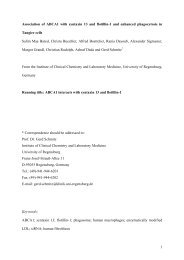Revealing Early Steps of 2 1 Integrin-mediated Adhesion to ...
Revealing Early Steps of 2 1 Integrin-mediated Adhesion to ...
Revealing Early Steps of 2 1 Integrin-mediated Adhesion to ...
You also want an ePaper? Increase the reach of your titles
YUMPU automatically turns print PDFs into web optimized ePapers that Google loves.
Figure 5. Dependence <strong>of</strong> cellular adhesion<br />
on substrate contact time. (A)<br />
CHO-A2 cell detachment forces were determined<br />
for contact times between 5 and<br />
600 s. Open circles in the diagram represent<br />
the detachment forces <strong>of</strong> individual<br />
cells for a given contact time, whereas the<br />
closed circles denote the corresponding<br />
mean detachment forces <strong>of</strong> all cells tested.<br />
For contact times �60 s, the detachment<br />
forces show wide variation. The S-shaped<br />
hand-drawn trend line (dashed) indicates<br />
a nonlinear increase <strong>of</strong> cellular adhesion<br />
with contact time. (B) Detachment force<br />
distribution measured for CHO-A2 cells<br />
for contact times <strong>of</strong> 30, 120, and 300 s<br />
displayed in a half-logarithmic scale. Two<br />
cell populations could be appreciated by<br />
eye. The first group contains cells displaying<br />
relatively weak adhesion <strong>of</strong> several<br />
hundred piconew<strong>to</strong>ns (nonactivated cells).<br />
After a contact time <strong>of</strong> 30 s, all tested cells<br />
fell in<strong>to</strong> the nonactivated group, whereas<br />
after longer contact times (120 and 300 s),<br />
their relative frequency gradually decreased.<br />
Instead, a second cell population displaying<br />
detachment forces <strong>of</strong> up <strong>to</strong> 20 nN (activated<br />
cells) emerged. Dashed line represents<br />
cut-<strong>of</strong>f force <strong>of</strong> 2 nN chosen <strong>to</strong><br />
separate groups. (C) Detachment forces<br />
(mean � SD) <strong>of</strong> activated cells (detachment<br />
forces �2 nN) and nonactivated<br />
cells (detachment forces �2 nN) for different<br />
contact times. Dashed line indicates<br />
cut-<strong>of</strong>f detachment force <strong>of</strong> 2 nN. (D)<br />
Time-dependent increase in the percentage<br />
<strong>of</strong> activated cells.<br />
(Evans and Ritchie, 1997; Merkel et al., 1999). With increasing<br />
loading rates the mean rupture forces, f m, increased from<br />
38 <strong>to</strong> 90 pN. Plotting the mean rupture force values versus<br />
the logarithm <strong>of</strong> the respective loading rates yielded a uniformly<br />
linear relationship (Figure 4C), which indicated an<br />
intermolecular potential with a single activation barrier. Applying<br />
Eq. 1 derived by Evans (Evans and Ritchie, 1997)<br />
based on the work <strong>of</strong> Bell (Bell, 1978) <strong>to</strong> the line fit (see<br />
Material and Methods), a dissociation rate k <strong>of</strong>f � 1.3 � 1.3 s �1 ,<br />
a lifetime <strong>of</strong> 0.8 � 0.7 s and a barrier width <strong>of</strong> 2.3 � 0.3 Å<br />
were determined for the � 2� 1 integrin/collagen I bond.<br />
Dependence <strong>of</strong> � 2� 1-Mediated <strong>Adhesion</strong> on Contact Time<br />
During the first 120 s <strong>of</strong> matrix contact, CHO-A2 cell adhesion<br />
increased almost 10-fold (Figure 3C). To investigate the<br />
time dependence <strong>of</strong> cell adhesion formation in more detail,<br />
we varied the contact time <strong>of</strong> CHO-A2 cells with the collagen<br />
matrix between 5 and 600 s, and we determined the<br />
respective detachment forces. For each contact time interval,<br />
�10 cells were analyzed, and several force curves were<br />
recorded per cell (Supplemental Table S1).<br />
For short contact times (5–10 s), CHO-A2 cells required<br />
forces <strong>of</strong> several hundred piconew<strong>to</strong>ns for matrix detachment<br />
(Figure 5A). With increasing contact time the mean<br />
detachment force grew slowly until after �60 s it increased<br />
quickly, reaching �5 nN after 180 s. Beyond 180 s, the mean<br />
� 2� 1 <strong>Integrin</strong> Force Spectroscopy<br />
detachment force continued <strong>to</strong> rise, albeit again more<br />
slowly. Thus, recording cell detachment forces over a time<br />
course <strong>of</strong> 10 min revealed a nonlinear buildup <strong>of</strong> adhesion<br />
force across the cell population. Three phases <strong>of</strong> adhesion<br />
formation could be distinguished: a first phase (�60 s) during<br />
which forces rose comparatively slowly (“initiation”), a<br />
second phase (60–180 s) <strong>of</strong> rapidly increasing adhesion (“reinforcement”),<br />
and a third phase (�180 s) <strong>of</strong> slow adhesion<br />
maturation (“maturation”).<br />
Because a single-cell technique was used, detachment<br />
forces <strong>of</strong> individual cells could be compared. Beginning after<br />
60 s <strong>of</strong> contact time, cell detachment forces showed considerable<br />
variation (from �0.5 N <strong>to</strong> 20 nN). This suggested that<br />
individual cells were in different adhesive states (Figure 5A).<br />
Moreover, for contact times �60 s, cells seemed <strong>to</strong> be distributed<br />
in<strong>to</strong> a low adhesion group (detachment forces below<br />
�2 nN) and a high adhesion group in which detachment<br />
forces ranged from �2 <strong>to</strong> 20 nN. To illustrate the<br />
presence <strong>of</strong> cell populations with different adhesive properties<br />
at specific points <strong>of</strong> the contact time course, detachment<br />
force distributions representative for the initiation (30 s),<br />
reinforcement (120 s), and maturation (300 s) phases were<br />
displayed in half-logarithmic his<strong>to</strong>grams (Figure 5B). During<br />
the initiation phase, detachment forces displayed a unimodal<br />
distribution and were below 2 nN (Figure 5B, <strong>to</strong>p).<br />
During the reinforcement and maturation phases, the de-<br />
Vol. 18, May 2007 1639
















